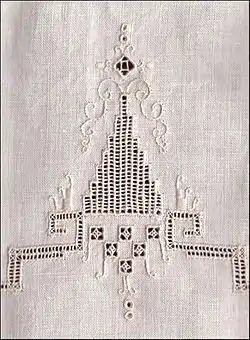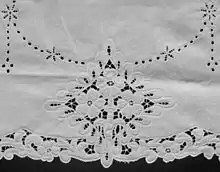Whitework embroidery
Whitework embroidery refers to any embroidery technique in which the stitching is the same color as the foundation fabric (traditionally white linen). Styles of whitework embroidery include most drawn thread work, broderie anglaise, Hardanger embroidery, Hedebo embroidery, Mountmellick embroidery, reticella and Schwalm. Whitework embroidery is one of the techniques employed in heirloom sewing for blouses, christening gowns, baby bonnets, and other small articles.

Description of the technique
The term whitework encompasses a wide variety of specific forms of embroidery and can refer to freestyle, counted thread, and canvas-work techniques.[1]:109 Whitework can also be divided into two categories, open and close, depending on whether the threads are cut.[2]:172 Open whitework includes drawn thread work and the related cutwork, in which threads are removed (drawn) from the background fabric, which produces an open, lacy effect.[3]:64 Examples of drawn thread work are broderie anglaise, Madeira, and Hardanger. Close embroidery is also known as pulled work, which produces an open effect as threads are manipulated, with some being grouped together and others pulled apart.[3]:70
History

Different styles of whitework emanated from different areas and at a variety of times in history. There are examples of pulled thread work from the 1200s. Prior to the 1500s, embroidered clothing and other textiles were limited to the church and to royalty.[4]:2 Dresden work, a pulled thread style, developed in Germany. In the early 1700s, it was popular as a substitute for lace.[5]:310 Broderie anglaise, which features eyelets, was particularly popular in the late 1800s. When the 9th-century tomb of St. Cuthbert was opened in the 12th century, an example of drawn thread work was found in it.[5]:310 Another form of whitework, cutwork, was found throughout Europe, but highly skilled cutwork originated in Italy. In the 1500s, Cardinal Richelieu introduced it to France.:310[5] It was so popular in the 1500s and 1600s in England that, by law, only the noble classes could wear it.[5]:310
References
- Embroidery : a maker's guide. Crow, Eleanor, Robson, Faye, Victoria and Albert Museum. [New York, NY]: Thames & Hudson. 2017. ISBN 978-0-500-29327-0. OCLC 990114748.CS1 maint: others (link)
- Caulfeild, S. F. A. (Sophia Frances Anne), 1824-1911. (1972) [1882]. Encyclopedia of Victorian needlework [Dictionary of needlework. Saward, Blanche C. New York: Dover Publications. ISBN 0-486-22800-2. OCLC 329676.CS1 maint: multiple names: authors list (link)
- Brown, Pauline. (1994). The encyclopedia of embroidery techniques. New York: Viking Studio Books. ISBN 0-670-85568-5. OCLC 30858977.
- Otsuka, Ayako (2017). Whitework embroidery : learn the stitches plus 30 step-by-step projects. Matthews, Kyoko. Lanham, MD: Stackpole Books. ISBN 978-0-8117-3822-4. OCLC 1114737787.
- The Royal School of Needlework book of embroidery : a guide to essential stitches, techniques and projects. Royal School of Needlework (London, England). Tunbridge Wells, Kent. ISBN 978-1-78221-606-3. OCLC 1044858813.CS1 maint: others (link)
- S.F.A. Caulfield and B.C. Saward, The Dictionary of Needlework, 1885.
- Virginia Churchill Bath, Needlework in America, Viking Press, 1979 ISBN 0-670-50575-7


